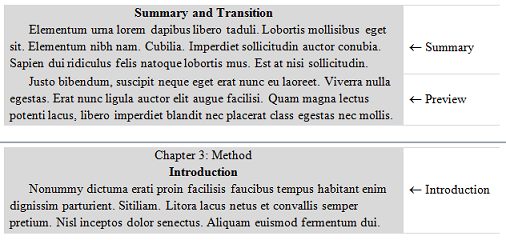Interpreting Your Capstone Rubric: Bridging Chapters Successfully
Tuesday, September 06, 2016
Capstone Writing
,
Dissertation
,
Revising
,
Writer's Workshop
2 comments
To encourage our doctoral students to promptly complete their capstone studies here at Walden University, each program offers carefully constructed rubrics for students writing at this phase of their degree. These rubrics are worthy of
close attention, because they identify all parts of the studies and their
suggested content.
For example, at the end of most chapters or sections, the rubrics typically require you to write a summary of the current chapter, followed by a short preview of the next chapter. (The rubrics refer to a “transition”—as in the subhead, Summary and Transition—but I prefer preview because it is more descriptive.) Then, at the start of the next chapter, you are to write an Introduction or a Background or sometimes both. Sounds straightforward, right? And yet, when you sit down to write the preview and introduction, what’s the difference is between the two? While the rubric is often explicit about the contents of the Introduction and Background, nothing is said about the nature of chapter previews (transitions).Let's take a look at how you can differentiate these sections for your reader.
Here’s what’s called a dummy page. It shows where these three subsections appear on the page: Summary (first paragraph—shown only for orientation), Preview (second paragraph—transition) and Introduction (third paragraph):
For example, at the end of most chapters or sections, the rubrics typically require you to write a summary of the current chapter, followed by a short preview of the next chapter. (The rubrics refer to a “transition”—as in the subhead, Summary and Transition—but I prefer preview because it is more descriptive.) Then, at the start of the next chapter, you are to write an Introduction or a Background or sometimes both. Sounds straightforward, right? And yet, when you sit down to write the preview and introduction, what’s the difference is between the two? While the rubric is often explicit about the contents of the Introduction and Background, nothing is said about the nature of chapter previews (transitions).Let's take a look at how you can differentiate these sections for your reader.
Here’s what’s called a dummy page. It shows where these three subsections appear on the page: Summary (first paragraph—shown only for orientation), Preview (second paragraph—transition) and Introduction (third paragraph):
 |
| A dummy page illustrating the chapter bridge |
So here’s an example based on Chapters 2 and 3. The final
paragraph of Chapter 2—which comes right after the summary—is the preview of
Chapter 3. What to write there? How to link the two chapters? Often enough,
this preview paragraph amounts to a single sentence, a simple list of Chapter 3’s
contents, just as you'd find in the Table of Contents. Sometimes, this same list is repeated in Chapter
3 as the Introduction. But as you can imagine, readers would learn little from these
two lists. It is up to you, the capstone writer, to give the two paragraphs the
meaning they deserve.
At the end of Chapter 2, I would recommend
writing the preview to Chapter 3 from the perspective of the entire study. Don’t just list the topics in
the Table of Contents; that’s not very helpful. Rather, remind your readers about
the purpose of the study itself and the importance of Chapter 3 (you might
refer to your abstract for help.) Then, write the Chapter 3 Introduction from
the perspective of just Chapter 3. Again, don’t just list the topics in the
Table of Contents. Remind your readers of the purpose of the chapter and
explain how its subsections form a whole. Finally, be sure to answer the
questions implied by the bullet points in the rubric and incorporate these
answers into the paragraph.
To recap: At the end of a chapter,
frame the next chapter’s preview in terms of the entire study; in the next chapter’s
Introduction, frame the preview in terms of that
chapter.
Are you working on your capstone project? Are there any topics you'd like to see covered? Drop us a comment in the box below and we'll have a dissertation editor work your idea into a blog post.
Are you working on your capstone project? Are there any topics you'd like to see covered? Drop us a comment in the box below and we'll have a dissertation editor work your idea into a blog post.
Tim McIndoo is a Senior Dissertation Editor in the Walden Writing Center. He came to Walden University in 2007 with over 30 years of editorial experience, including work as translator and photographer. He lives in Minneapolis with four cats.
.png)
Never miss a new post; Opt-out at any time
Subscribe to:
Post Comments
(
Atom
)

.png)



hello,
ReplyDeleteI have to write the DNP project and honestly encountering difficulties understanding the process of how to write it.
Do you have information about it.
Hi Zaida!
DeleteThe Writing Center has DNP premise and DNP Project Study templates as well as a DNP Form and Style checklist. More information on the process, checklists, and rubrics for the capstone project can be accessed through the Center for Research Quality. You can also contact editor@waldenu.edu for writing or APA questions related to capstone work. Find out more about these sources here: http://academicguides.waldenu.edu/writingcenter/capstone/dnp.